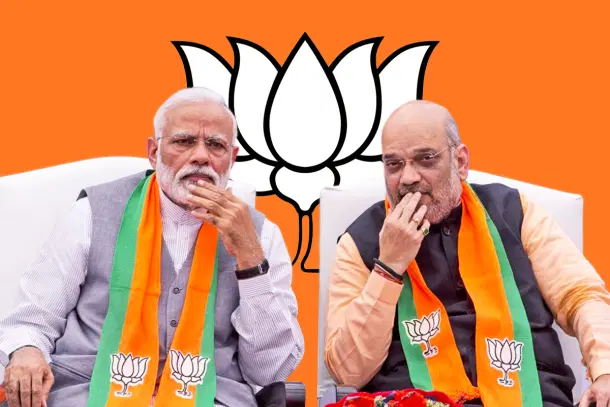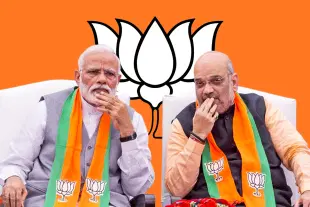Politics
14 Reasons What — Lessons And Implications Of PM Modi's 'Blitzkrieg' On New Chief Ministers
Banuchandar Nagarajan
Dec 13, 2023, 03:56 PM | Updated Dec 14, 2023, 06:09 PM IST
Save & read from anywhere!
Bookmark stories for easy access on any device or the Swarajya app.


No one could guess the names of three new chief ministers — Vishnudeo Sai of Chhattisgarh, Mohan Yadav of Madhya Pradesh and Bhajan Lal Sharma of Rajasthan.
Even the analysis after the announcements have largely focused on one aspect of the moves, namely, the caste affiliations of the appointees.
Let us see if there is further more to learn.
1. Prime Minister Narendra Modi and Home Minister Amit Shah have their sights on the path ahead, an attitude captured well in the ice-hockey star Wayne Gretzky's quote, "I skate to where the puck is going to be, not where it has been."
In calculating the groups to embrace viz. Brahmins, Scheduled Castes (SCs) etc, they are focused on the onward political journey of 2024 and beyond. Analysts, on the other hand, have based their thinking on the past.
Their rearview mirror analyses takes bets on which groups will be rewarded for voting, an event that has already happened.
2. Analysts do not know organisational subtleties, relationship nuances and micro-histories. For instance, Bhajan Lal Sharma was general secretary in Rajasthan for 25 years. Vishnudeo Sai did not contest elections in 2018 and 2019 and was building the organisation as the state unit president of BJP.
3. Modi-Shah are so powerful that they can make bold and unthinkable choices. Being nonpareil leaders, the organisation can do nothing but mutely accept decisions. The grammar of peer acceptability is not applicable in the current BJP set up.
If the hive mind works, then it will choose candidates acceptable to everyone, and hence, will be easier for observers to guess. Consensual decision making was taken to the extreme during the time of UPA (United Progressive Alliance) to such an extent that journalists and non-party functionaries were lobbying for candidates.
People of India were fed up with those cosy structures and hence are relishing the projection of moral authority by Modi-Shah.
4. Point #3 is predicated on the mutual trust of Modi-Shah and the people of India. People trust that Modi-Shah will do what is right even if hatke decisions are made.
Surveys indicate that around 20 percentage points for the BJP's vote share comes from the Prime Minister's name. In reciprocity, the Prime Minister is mindful about that privilege. He constantly communicates with the people on his programmes and philosophies.
5. This blitzkrieg move is a signal to ministers and other senior leaders of the party and government that Modi-Shah can take surprising decisions that will be unquestioned and that they better focus on their jobs and loyalties.
6. Feedback of various party officials through the Prime Minister’s secondary channels that have propelled "unknown" leaders. If you ask any karyakarta, their biggest worry would be the fear of being unseen.
These surprise moves will incentivise karyakartas to work with hope. Now, everyone knows they are being watched — both for getting pushed up the organisation or for being pulled down to oblivion. Bhajan Lal Sharma won from Sanganer. The powerful former mayor of Jaipur and incumbent MLA of Sanganer, Ashok Lahoti, did not even get a ticket.
7. Separation of politics and administration is very evident. Political identities and contribution to party will garner success. Perception of administrative abilities is secondary. Babus can be sambhaloed to get work done. Similar and even harsher (dis)incentives apply to the bureaucracy. Ask the former star secretaries of government of India.
8. Organisational change and timing out of the old guard looks as important a political objective as wielding stable administrations under widely-acceptable faces. The consequent upward mobility of cadre is super important in a fast-growing party.
9. New faces will work hard and be utterly loyal to Modi-Shah. Downside political risks, such as not following diktats are thus covered. The morale of the organisation leading to 2024 will be high, as party workers will work hard to into the good books of the new leaders. In BJP's model — Modi's name + booth committee — the latter hinges on the last-mile karyakarta. Her hopes bring energy to political outreach.
10. Modi-Shah have orchestrated this political dance, have also ensured that no community feels short changed. Remember upper caste anger five years ago and subsequent 10 per cent Economically Weaker Section (EWS) reservation?
Perception issues that creep in during transitions can have deep psychological impact on voters. Opposition parties can take advantage of them. Other Backward Class (OBC), tribal, Brahmin, Rajput, women, SC, ST all find place in the leadership group of the three states.
11. Let us not forget the realpolitik — the silent negation of legacies of Vasundhara Raje Scindia and Shivraj Singh Chauhan — by appointing rank-new faces and disarming their loyalists.
12. Modi-Shah have taken a pan-Indian view of politics even when effecting changes in individual states. Case in point in the appointment of Mohan Yadav as Chief Minister of Madhya Pradesh, which will have repercussions in Uttar Pradesh, Bihar, Rajasthan, Haryana, and similar castes all over India (such as Konars of Tamil Nadu). OBCs such as Yadavs form the base of regional parties — Samajwadi Party in Uttar Pradesh and Janata Dal-United in Bihar.
In those states, the strategy of the BJP in the past has have been to work out a coalition of smaller OBCs against larger OBCs such as Yadavs and Kurmis. The current move, offering a welcome sign to Yadavs is akin to marching right into enemy territory viz. of SP and JD-U, especially when these parties are weak.
13. Not many have noticed the long-term vision in the current appointments. BJP's larger trajectory is of going beyond forward castes and even OBCs. A vote bank of united Hindu spectrum is being constructed before our eyes. The project of mainstreaming of smaller OBCs, SC, ST groups is well underway. Subalterns will be the drivers of BJP within this decade.
14. It is true that Modi-Shah are ultra-powerful. It is true that they have sources of information that analysts do not have access to. But it will be disingenuous not to acknowledge that Modi-Shah are much brighter than the brightest analyst. Their deep experience and extraordinary intelligence make them #GOATs of Indian politics.
Journalists and analysts that watch politics closely feel disheartened when none of their predictions come true (including yours truly). But analysts should realise that they are like amateurs playing against the likes of Novak Djokovic and Rafael Nadal.
Hence, events such as these should not discourage political watchers from speculating on names. Just that, it should be backed by proper logic, lest it be misconstrued as lobbying (it doesn't matter anyway under the current set-up). The explanation of that logic has value in public sphere.
These days big name journalists and commentators abstain from deep analysis of names of CM contenders worrying that they may lose face (or get exposed for lack of depth in analysis) if they get it wrong. They should not succumb to cowardice by dropping out of the debate altogether. They should remember that the process is the reward.
Banuchandar is a political and public policy advisor. He posts at @Banu4Bharat.





